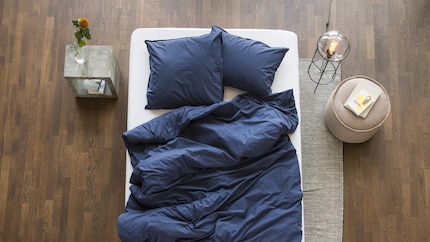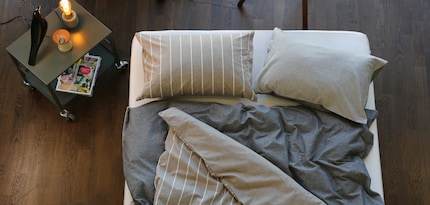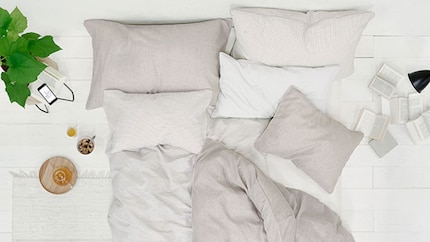
Guide
Yet another reason to hide under the duvet
by Pia Seidel
A good night's sleep is worth its weight in gold. That's why choosing the right bed linen is just as important as buying a duvet that suits you. I'll tell you which are the most popular materials for duvet covers.
For me, the best moment of the day is when I fall into bed exhausted in the evening and snuggle up in my duvet. That's why I prioritise quality and the right material when it comes to sheets. If they are not breathable, for example, I can easily sweat while I sleep. What's more, the duvet cover can become quite scratchy if not cared for properly, as was once the case in a hotel I stayed at in Paris. The sheets were as hard as stone and my night's sleep was correspondingly uncomfortable. I'll tell you which material is the right choice for you and what you should look out for when cleaning your duvet covers.

Perkal is Persian and means something like cloth. The dense cotton fabric is not only soft, but also hard-wearing and abrasion-resistant. In direct comparison with conventional cotton bed linen, percale has a higher thread density, which makes the fabric softer, stronger and smoother. One advantage of this fabric is its durability. In addition, its breathable properties make this sheet a year-round companion.
Here you can find all models made of percale.
Jersey is a stretchy woven fabric made from cotton or synthetics. Its soft surface has a velvety finish. In addition to its suppleness, jersey scores points for its absorbency, which makes it ideal for the warm summer months. Another point in the material's favour is that it is easy to care for. In other words, it can withstand high temperatures, can be tumble dried and is crease-resistant. Its elasticity is the only drawback of jersey, as it can wear out over time.
Here you can find all jersey models.

There's nothing better in winter than a cosy bed. Flannel is ideal for this, as the surface of the cotton fabric is not only warm but also soft. The material is roughened during production. This creates spaces in the fibres that store air and therefore also body heat. Another advantage: there are no creases, so you don't need to iron the fabric after washing.
Here you can find all flannel models.

If you like the slightly coarse and firm feel of linen, you'll love it. The material has a cooling effect in summer, is lint-free and absorbent. If you tend to sweat, the fabric is the best choice as it is breathable, absorbs moisture and, unlike other styles, dries quickly. Ironing is unnecessary because the different thread thicknesses create a slightly creased look, which is intentional. Pure linen is also suitable for allergy sufferers, as the natural material repels dust and mites.
Here you can find all linen models.
The shiny noble fibre feels soft and cool at the same time. Nevertheless, silk is equally suitable for all seasons as it has cooling and warming properties. Because it moulds perfectly to the skin, it warms. In summer, on the other hand, it releases moisture to the outside. If you decide in favour of this material, you will not only have to dig deep into your wallet, but also bear in mind that the fabric is delicate and anything but easy to care for. Low temperatures when washing or dry cleaning are a must.
We do not currently have any silk models. This is why you can find the entire bed linen range here.
When I’m not exploring the depths of the sea as an open water diver, I enjoy plunging into the world of fashion. On the streets of Paris, Milan and New York is where I keep my eyes peeled for the latest trends. And I’ll show you how to take them from the catwalk to your everyday life.
Practical solutions for everyday problems with technology, household hacks and much more.
Show all